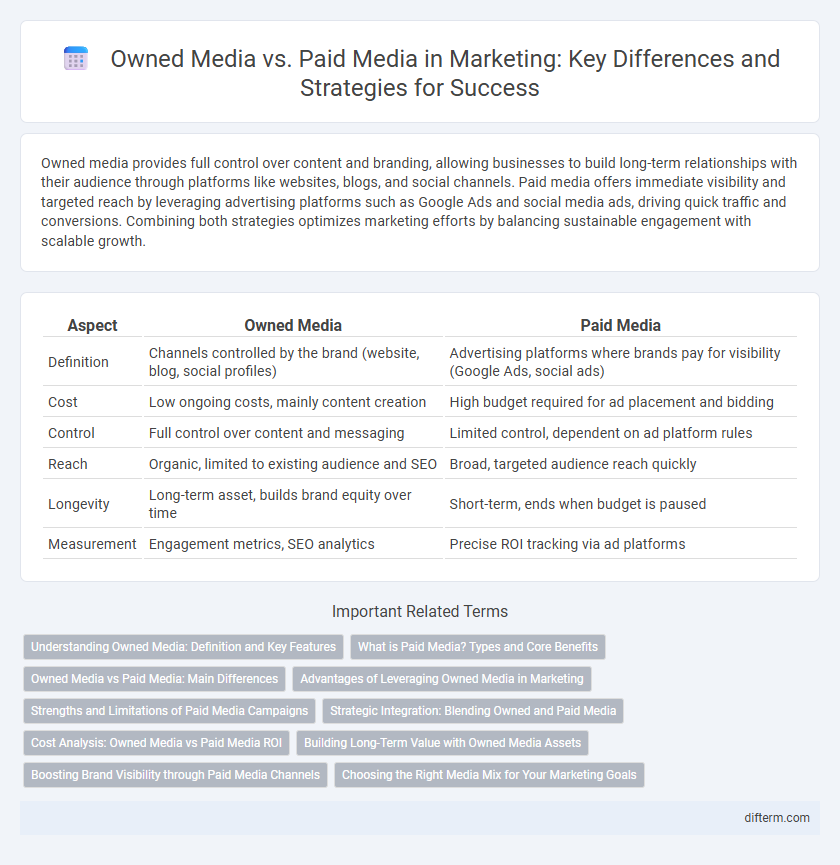Owned media provides full control over content and branding, allowing businesses to build long-term relationships with their audience through platforms like websites, blogs, and social channels. Paid media offers immediate visibility and targeted reach by leveraging advertising platforms such as Google Ads and social media ads, driving quick traffic and conversions. Combining both strategies optimizes marketing efforts by balancing sustainable engagement with scalable growth.
Table of Comparison
| Aspect | Owned Media | Paid Media |
|---|---|---|
| Definition | Channels controlled by the brand (website, blog, social profiles) | Advertising platforms where brands pay for visibility (Google Ads, social ads) |
| Cost | Low ongoing costs, mainly content creation | High budget required for ad placement and bidding |
| Control | Full control over content and messaging | Limited control, dependent on ad platform rules |
| Reach | Organic, limited to existing audience and SEO | Broad, targeted audience reach quickly |
| Longevity | Long-term asset, builds brand equity over time | Short-term, ends when budget is paused |
| Measurement | Engagement metrics, SEO analytics | Precise ROI tracking via ad platforms |
Understanding Owned Media: Definition and Key Features
Owned media refers to digital assets and content controlled directly by a brand, such as websites, blogs, social media profiles, and email lists, enabling businesses to build long-term customer relationships without ongoing advertising costs. Key features include full control over messaging, consistent brand voice, the ability to engage audiences through personalized content, and enhanced opportunities for SEO optimization. Owned media serves as the foundation for integrated marketing strategies, driving organic traffic and fostering authentic interactions with target audiences.
What is Paid Media? Types and Core Benefits
Paid media refers to external marketing efforts that involve paying for ad placements, including platforms like Google Ads, social media advertising (Facebook, Instagram, LinkedIn), and display ads. Key types of paid media include search engine marketing (SEM), social media ads, influencer partnerships, and sponsored content. Core benefits of paid media are enhanced brand visibility, immediate traffic generation, precise audience targeting, and measurable ROI through comprehensive analytics.
Owned Media vs Paid Media: Main Differences
Owned media refers to digital assets a company controls, such as websites, blogs, and social media profiles, enabling direct audience engagement without ongoing costs. Paid media involves purchasing advertising space on external platforms like Google Ads, Facebook Ads, or influencer partnerships to amplify reach quickly but requires continuous investment. The main differences lie in control, cost, and scalability: owned media offers long-term brand authority with zero media spend, while paid media delivers immediate visibility but with less control and higher expenses.
Advantages of Leveraging Owned Media in Marketing
Owned media offers businesses complete control over content, allowing consistent brand messaging and personalized audience engagement without ongoing media buying costs. It enhances long-term customer relationships through direct communication channels such as websites, blogs, and email newsletters, fostering trust and loyalty. Leveraging owned media also provides valuable data insights to optimize content strategies and improve marketing ROI more efficiently than paid media campaigns.
Strengths and Limitations of Paid Media Campaigns
Paid media campaigns offer precise targeting capabilities and immediate reach across multiple platforms such as social media, search engines, and display networks, driving rapid brand awareness and lead generation. However, the cost of paid media can escalate quickly, and campaign effectiveness depends heavily on budget allocation and continuous optimization to avoid diminishing returns. Unlike owned media, paid campaigns lack long-term asset value, as visibility ceases once the ad spend stops, limiting sustained engagement and organic growth.
Strategic Integration: Blending Owned and Paid Media
Strategic integration of owned and paid media maximizes marketing effectiveness by leveraging the control of owned channels with the reach of paid advertising. Combining data from owned media platforms like websites, blogs, and social channels with targeted paid campaigns enables precise audience segmentation and personalized messaging. This blended approach enhances brand consistency while driving customer engagement and conversion across multiple touchpoints.
Cost Analysis: Owned Media vs Paid Media ROI
Owned media typically requires a lower upfront investment, leveraging existing channels like websites, blogs, and social media profiles, resulting in higher long-term ROI due to minimal ongoing costs. Paid media involves direct expenses for ads, such as PPC campaigns and display ads, often delivering faster but more variable returns dependent on budget and targeting efficiency. Cost analysis reveals owned media excels in sustainable growth and brand equity building, while paid media drives immediate traffic and conversions with controlled spending.
Building Long-Term Value with Owned Media Assets
Owned media assets like websites, blogs, and social media channels create lasting value by fostering direct relationships with audiences and enabling consistent brand messaging. These channels enhance customer loyalty and generate sustainable organic traffic, reducing reliance on fluctuating paid advertising costs. Investing in owned media builds a durable digital presence that compounds over time, driving long-term marketing success and higher return on investment.
Boosting Brand Visibility through Paid Media Channels
Paid media channels, such as social media ads, search engine marketing, and display advertising, significantly amplify brand visibility by targeting specific audience segments with high precision. Unlike owned media, paid media offers immediate reach expansion and measurable performance metrics that drive strategic adjustments. Leveraging paid media campaigns enhances brand awareness, accelerates customer acquisition, and maximizes return on investment through optimized ad placements and audience targeting.
Choosing the Right Media Mix for Your Marketing Goals
Owned media, such as websites, blogs, and social media profiles, offers long-term brand equity and cost-effective audience engagement, making it ideal for nurturing customer relationships and creating authentic content. Paid media, including pay-per-click ads, social media ads, and sponsored content, delivers immediate visibility and precise targeting capabilities to quickly drive traffic and conversions. Selecting the optimal media mix requires aligning your marketing goals with budget constraints, audience behavior, and the balance between short-term impact and sustained brand growth.
Owned Media vs Paid Media Infographic

 difterm.com
difterm.com